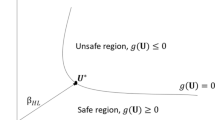Abstract
One method of monitoring corrosion in an underground storage tank involves placing a sensor in the tank and running it around the tank's interior. As it runs, the sensor records the local thickness of the tank. In this paper we consider the problem of estimating the maximum pit depth by providing a confidence interval that achieves both a specified confidence level and a specified degree of precision. A particular model, the three-parameter beta, is considered, and a stopping rule for determining the sample size is proposed. It is shown that the stopping rule achieves the desired confidence level and precision, asymptotically as the precision requirement becomes increasingly stringent. Moreover, the stopping rule is asymptotically efficient in terms of sample size. The limiting distribution of the stopping rule is derived, and simulation results are presented to supplement the asymptotics with finite sample size behavior.
Similar content being viewed by others
References
Alvo, M. (1978). Sequential estimation of a truncation parameter, J. Amer. Statist. Assoc., 73, 404–407.
Basawa, I. V., McCormick, W. P. and Sriram, T. N. (1990). Sequential estimation for dependent observations with an application to non-standard autoregressive processes, Stochastic Process Appl. 35, 149–168.
Chow, Y. S. and Robbins, H. (1965). On the asymptotic theory of fixed-width confidence intervals for the mean, Ann. Math. Statist., 36, 457–462.
Chow, Y. S. and Yu, K. F. (1981). On the performance of a sequential procedure for estimation of the mean, Ann. Statist., 9, 184–189.
de Haan, L. (1981). Estimation of the minimum of a function using order statistics, J. Amer. Statist. Assoc., 76, 467–469 (Correction: ibid. (1983), 78, p. 1008).
Galambos, J. (1978). The Asymptotic Theory of Extreme Order Statistics, Krieger, Malabar, Florida.
Ghosh, M. and Mukhopadhyay, N. (1975). Sequential point estimation of the parameter of a rectangular distribution, Calcutta Statist. Assoc. Bull., 24, 117–122.
Graybill, F. A. and Connell, T. L. (1964). Sample size required to estimate the parameter in the uniform density within d units, J. Amer. Statist. Assoc., 59, 550–556.
Leadbetter, M. R., Lindgren, G. and Rootzén, H. (1983). Extremes and Related Properties of Random Sequences and Processes, Springer, New York.
Mukhopadhyay, N., Ghosh, M., Hamdy, H. and Wackerly, D. (1983). Sequential and two-stage point estimation for the range in a power family distribution, Sequential Anal., 2, 259–288.
Rosengard, A. (1962). Etude des lois-limites jointes et marginales de la moyenne et des valeurs extréme d'un enchantillon, Publications de l'Institut de Statistique de l'Université de Paris, 11, 3–53.
Sriram, T. N. (1987). Sequential estimation of the mean of a first-order stationary autoregressive process, Ann. Statist., 15, 1079–1090.
Tiago de Oliveira, J. (1961). The asymptotic independence of the sample mean and extremes, Revista da Faculdade de Ciencias, University Lisbon, A8, 299–309.
Woodroofe, M. (1982). Nonlinear Renewal Theory in Sequential Analysis, Society for Industrial and Applied Mathematics, Philadelphia.
Author information
Authors and Affiliations
About this article
Cite this article
Martinsek, A.T. Sequential Estimation of the Maximum in a Model for Corrosion Data. Annals of the Institute of Statistical Mathematics 52, 646–657 (2000). https://doi.org/10.1023/A:1017569108778
Issue Date:
DOI: https://doi.org/10.1023/A:1017569108778




